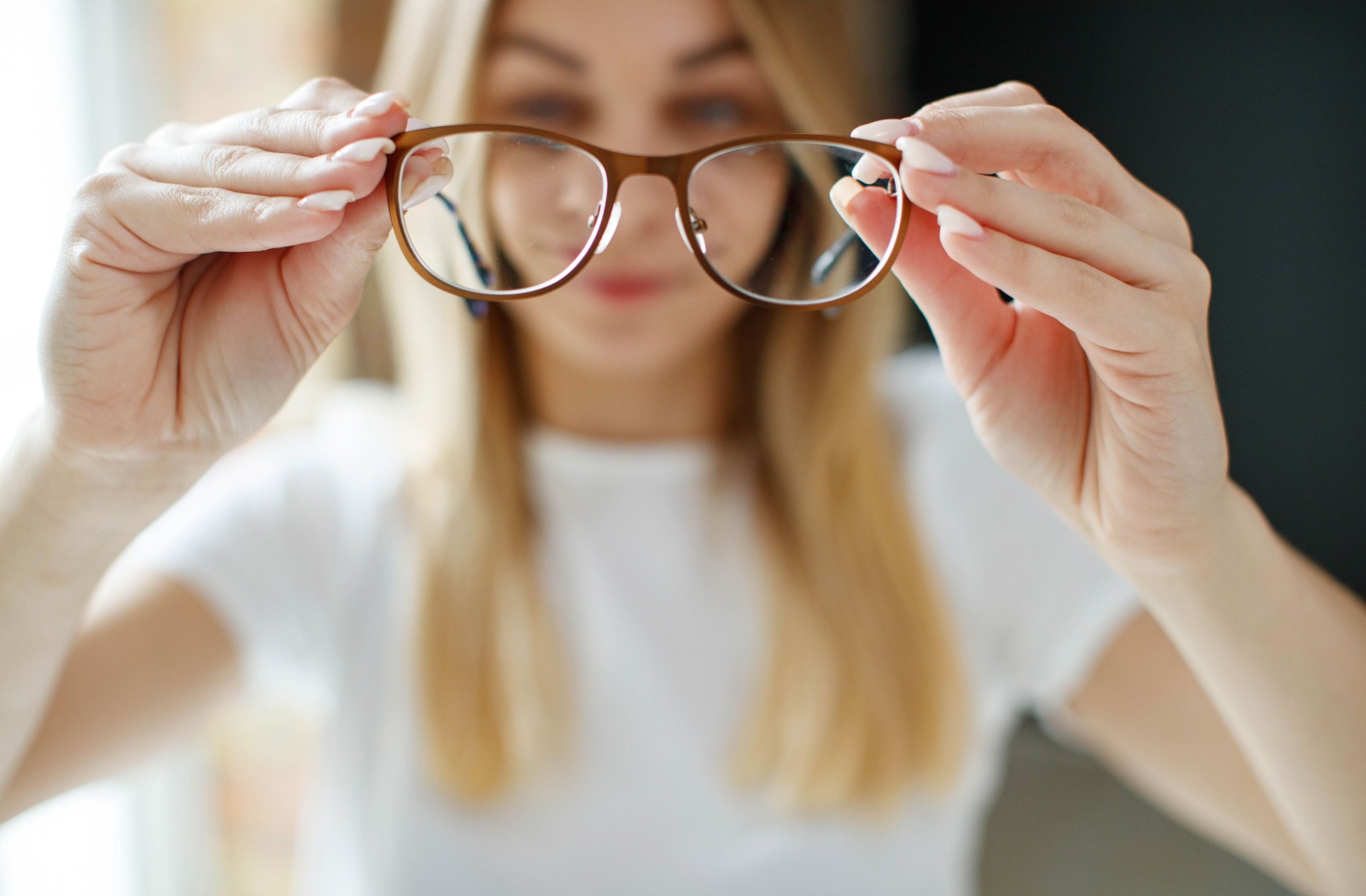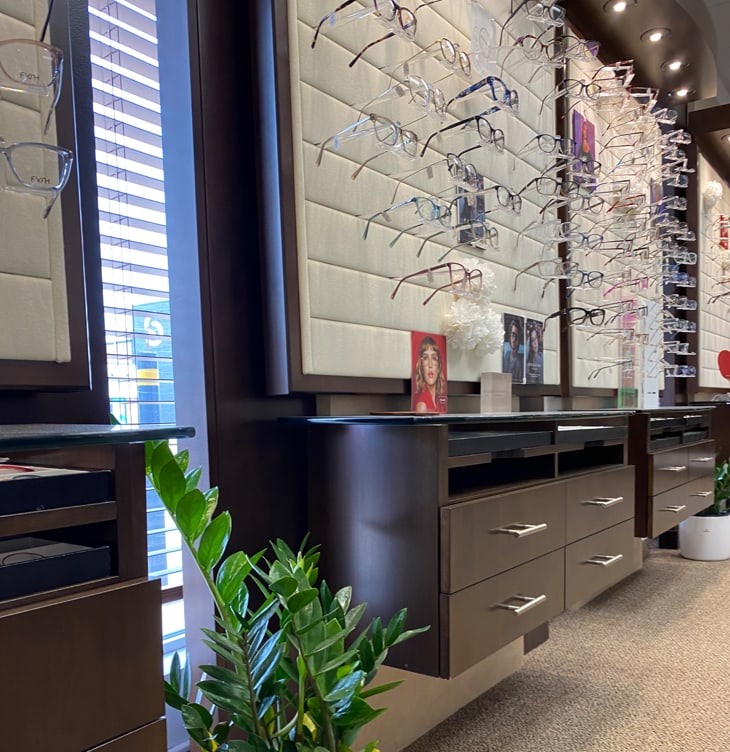Astigmatism and myopia are common eye conditions. While both are refractive errors that cause blurred vision, they develop for different reasons. Astigmatism is due to an abnormally shaped cornea or lens, while myopia results from an elongated eyeball or curved cornea.
If you suspect you have astigmatism or myopia, schedule a comprehensive eye exam. We can suggest treatment options to help you see more clearly.
What Is Astigmatism?
Astigmatism is a common vision condition that causes your vision to appear blurry. Many people have some level of astigmatism; however, when it’s more pronounced, it can interfere with daily tasks (such as driving) and lead to headaches. Astigmatism is not considered a disease.
Causes
Astigmatism arises when the lens or the front of the cornea are irregularly shaped. The result is blurry vision regardless of distance.
Factors associated with the development of astigmatism include genetics and eyelid pressure on the cornea. Astigmatism can also happen after an eye injury or surgery. A progressive disease called keratoconus can also cause the condition.
Children can develop astigmatism early in life—one reason why regular eye exams for children are so important.
Symptoms
Common symptoms of astigmatism include:
- Blurred or distorted vision—this is the most common symptom
- Eye discomfort or strain
- Needing to squint to focus
- Headaches
- Glare, including seeing halos and/or starbursts surrounding lights
- Digital eye strain
Astigmatism often coexists with other refractive errors, such as myopia (nearsightedness) or hyperopia (farsightedness).
What Is Myopia?
Myopia is commonly called “nearsightedness” and occurs when a person has trouble seeing objects at a distance. Nearby objects remain clear and in focus, depending on the degree of myopia you have. Similar to astigmatism, myopia is a refractive error.
In recent years, myopia has become more common. It’s estimated that, by 2050, half the world’s population will have myopia.
Causes
Nearsightedness happens when the eyeball is too long or the cornea is too curved in shape. These structural changes prevent light from focusing properly on the retina at the back of the eye, leading to blurry vision for distant objects.
Both genetics and environmental factors can contribute to the development of childhood myopia. If you have parents with myopia, you’re more likely to develop the condition. It can also progress (get worse) faster in children whose parents are myopic. Behaviours like reading and using close devices like phones and tablets are also associated with myopia development. In contrast, increased time spent outdoors has been shown to delay the development of myopia.
Symptoms
Here are some typical myopia symptoms:
- Nearby objects are clear, but objects at a distance are hazy
- Eye strain and headaches
- Needing to squint to focus
- Activities that require distance vision, such as sports, driving, or watching a presentation, are especially tiring
- Children with untreated myopia may struggle at school

Options for Astigmatism & Myopia
While astigmatism and myopia can vary in severity, they both can impact your daily life. Fortunately, there are several ways to manage symptoms.
Managing Astigmatism
Ways to correct astigmatism include:
- Prescription eyewear: Glasses are a common and easy way to correct astigmatism. Prescription lenses compensate for the uneven shape of the cornea or lens, helping you see more clearly. With so many designs available, you can find glasses that express your personality and complement your face shape!
- Contact lenses: Some people find contact lenses more convenient and aesthetically pleasing, but be aware that contacts require more care and high attention to hygiene.
- Laser and refractive surgery: If you’re considering a more permanent solution, laser surgeries such as LASIK can reshape the cornea to correct astigmatism.
- Orthokeratology (Ortho-K): This non-surgical method uses gas-permeable contact lenses to reshape the cornea overnight. The next day, you’ll experience clear vision without needing to wear contacts or eyewear. This option is most suitable for mild astigmatism.
Managing Myopia
The refractive error from myopia can be corrected using methods like:
- Eyeglasses and contacts: These are the most common vision correction options for myopia correction. They don’t require surgery.
- Laser refractive surgery: Lasers can reshape your cornea and fix refractive errors like myopia. LASIK, wavefront-guided LASIK, and PRK (photorefractive keratectomy) are types of laser surgery, but not everybody is an appropriate candidate.
- Orthokeratology (Ortho-K): Overnight corneal reshaping therapy is a non-surgical correction method safely used for myopia correction up to six (6) diopters. A corneal profile, or topography, is needed to ensure you are a good candidate.
- Slowing myopia in children: Treatments like orthokeratology and atropine eye drops can slow myopia’s progression in children. Spending more time outdoors may also help slow myopia progression. Just remember to wear sunglasses and sunscreen!
Prescription eyewear and surgeries don’t cure myopia; all they do is change the way light interacts with your eye. This means that even after surgery, you’re still potentially at risk of developing serious conditions like retinal detachment, glaucoma, and myopic maculopathy, depending on the severity of your myopia before the procedure.
Astigmatism & Myopia Care in London, ON
If you have symptoms of a refractive error and are wondering if you have astigmatism or myopia, see your optometrist for a comprehensive eye exam. In general, adults between the ages of 20 and 64 should get their eyes checked once every two years. More frequent eye exams may be recommended for those with certain health conditions—for example, people with diabetes should get an eye exam every year.
Old South Optometry is an eye care clinic serving the London, ON area. Respect, accessibility, encouragement, and teamwork are core to our team’s values. We offer eye exams for adults and children, as well as myopia control options and contact lens fittings. Book an eye exam with us today.











